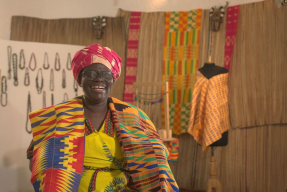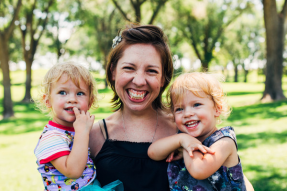This microfinance partnership creates sustainable incomes in the Mlabri village of Thailand
August 4, 2022
It’s hard to imagine creating a positive impact around the globe by simply swinging in a hammock, but Joe Demin and Rachel Connors have made it possible to do just that.
The married co-founders of Yellow Leaf Hammocks sell their comfy, colorful wares using a scalable business model that brings reliable income to the Mlabri and other hill tribes of Thailand’s mountainous northern region—where more than 64 percent of people live below the poverty line.
“I realized if we focused on quality and design first, it could potentially create a sustainable path out of poverty for everybody in this region.”
The couple has created jobs for more than 225 hill residents, who earn what Yellow Leaf Hammocks calls a “prosperity wage” by weaving the popular hammocks that now hang in thousands of homes throughout the world. With sales skyrocketing, the company expects to employ 400 weavers by the end of 2022.
The Los Angeles-based entrepreneurs knew that in order to build a brand that could make long-term social change, they had to start with a product that people loved to hang in.
“I realized if we focused on quality and design first, it could potentially create a sustainable path out of poverty for everybody in this region—and build a business that can be successful financially,” says Joe, who acts as Yellow Leaf Hammocks’ CEO but prefers the term “Chief Relaxation Officer.”
Rachel, who handles marketing channels as the company’s “Chief Enthusiasm Officer,” agrees that the skill of their artisans and caliber of their work is the foundation of their success.
“We really lead with the fact that you're going to have an amazing experience in this hammock, it's going to look so great in your yard and bring you joy,” she explains. “The cherry on top is, there's this great impact story.”
Bringing the vacation home
The story began in 2011, when Joe took a vacation to Thailand with some friends and found an incomparably soft, well-constructed hammock in an outdoor market. When he learned it was made by an indigenous group of people working to improve the quality of life in their village, he ditched his buddies and took a cab ride into the hills to learn more.
What he encountered would change the course of his life—and that of many others.
Known as “People of the Yellow Leaves” for the color of their thatched roof shelters, the Mlabri used to live off of the land, but by the 1970s, rapid economic development in Thailand had stripped their forests of their natural bounty. Without their homes and livelihood, and with no civil rights, the Mlabri were especially vulnerable to exploitation. Malnourishment and malaria contributed to the rapid dwindling of the tribe’s population, and those who survived were forced into servitude for neighboring tribes.
In the late 1970s, an aid worker helped a few of the less than 300 Mlabri left learn to weave hammocks and distribute them.
“Through this small program, they were already able to have an impact on a small scale on their community,” recalls Joe. “I was already aware of the poverty issues in the developing world and the social impact a business could have, and I had always loved hammocks—”
“I just need to interject and say that Joe was obsessed with hammocks,” says Rachel with a laugh. “He would drag me into stores but he didn’t own one because he couldn’t find the perfect one.”
Fascinated by the potential of his new favorite item and the hospitable, gentle people he’d met, Joe returned home with a backpack full of hammocks and a business plan.
“I realized there was an opportunity to build a lifestyle brand focused on bringing the vacation back home and also create lasting change,” he says.
The couple had only been dating for a few months, and Rachel had no idea this was the beginning of a full-time venture that would take both of them back to Thailand many times over the next decade.
“I thought, well, this sounds like a fun little side hustle,” she says with a smile. “The great thing about my shock was that Joe had to test the marketing on his hardest customer, which was me.”
Scaling with Kiva
They sold their first hammocks at fairs and festivals, figuring out the nitty-gritty of e-commerce and working to tap into the growing social enterprise movement. Growth was slow until the 2015 SOCAP conference in San Francisco, where they caught the eye of Kiva’s impact investment team.
“The social impact is embedded in the business model; if the weavers thrive, then Yellow Leaf Hammocks will be able to thrive as a business too,” notes Kiva social enterprise investment manager Catalina Torres Perez. “As a result, there is no risk of mission drift.”
Back then, the concept of “impact investing” was still fairly new, and Yellow Leaf Hammocks entered into an experimental partnership with Kiva that extended a $20,000 line of credit to grow the company.
“The experimental partnership did two things,” says Rachel. “One, it gave us a ton of validation that we were on the right track. And it also allowed us to guarantee income for the initial group of women who started the program with us.”
 With quality hammocks and a path towards economic development in the Mlabri region of Thailand, Yellow Leaf Hammocks is making a real difference.
With quality hammocks and a path towards economic development in the Mlabri region of Thailand, Yellow Leaf Hammocks is making a real difference.The partnership with Kiva has evolved over the years to allow Yellow Leaf Hammocks to employ more and more weavers, through loans that allow them to purchase their weaving supplies for a year. The company acts as a lending partner, adhering to Kiva’s monitoring requirements and allowing for flexible repayment periods, so the weavers can sell their hammocks to help them repay their loan.
"[The weavers] determine what they want their salary to be and then we help them decide if that cadence of hammock production fits their lifestyle.”
“Unlike other partners, Yellow Leaf Hammocks doesn’t charge interest rates to weavers,” explains Catalina.
“Kiva’s zero percent interest rate capital is transferred to the weavers at a zero percent cost, and the company assumes the costs attached to managing Kiva’s credit line.”
The autonomy and agency of its employees are tantamount to the company’s founders. Full-time weavers produce between five and ten hammocks a month, choosing when and how much they want to work.
“We do a consultation with them before the Kiva loans are posted to talk to them about what they want for the coming year,” says Rachel. “They determine what they want their salary to be and then we help them decide if that cadence of hammock production fits their lifestyle.”
The formula has enabled Yellow Leaf Hammocks to expand training and employment to two other communities, the Hmong and Thai River people, and the Thai government has pledged funds for a more formal training program.
Most of the Yellow Leaf Hammock weavers are women, and the company website shows them talking and laughing in the shade at their looms, their children playing at their feet. While the Mlabri language is still on the UNESCO Endangered Languages list, their population is growing. Joe and Rachel marvel at how many children have grown taller than their parents due to increased nutrition and access to food.
“Our Theory of Change is that the best way to bring a family out of poverty is to give a mom a good job,” admonishes Rachel, adding that husbands often end up assisting their wives by helping them prepare yarn or other tasks.
“The goal is that we enable the family to have enough time in the day and enough breathing room that they can figure out something else to pursue.”
Inspiring a generation of entrepreneurs
As demand for their hammocks increases and allows their workforce to expand, Joe and Rachel have widened their lens for customer experience.
“For the last ten years, we’ve been focusing on selling woven hammocks, and it was difficult without having a way to hang it,” says Joe, alluding to a new line of straps, hooks and other accessories coming later this year. “So the immediate focus right now is on creating design-driven, innovative solutions for people to bring hammocks into their lives.”
The enterprising millennials also hope to inspire others to envision business models that make an impact.
“I think in our generation at least, people spend a lot of time worrying about the meaning of their life and whether they’re doing enough,” muses Rachel.
“My dream is that we could help recruit entrepreneurs to do something like what we’re doing and use Kiva as the seed money.”
While they remain committed to their mission and the Thai communities that both benefit from it and make it possible, the relaxation power couple also tries to swing in their own hammocks as much as they can.
As Rachel reminds gently, “We all need time to recharge.”
PREVIOUS ARTICLE
“We create so much more than jobs”: How this Black-owned business offers moms a work-life balance →NEXT ARTICLE
A Kiva loan helped this master craftsman master e-commerce →












